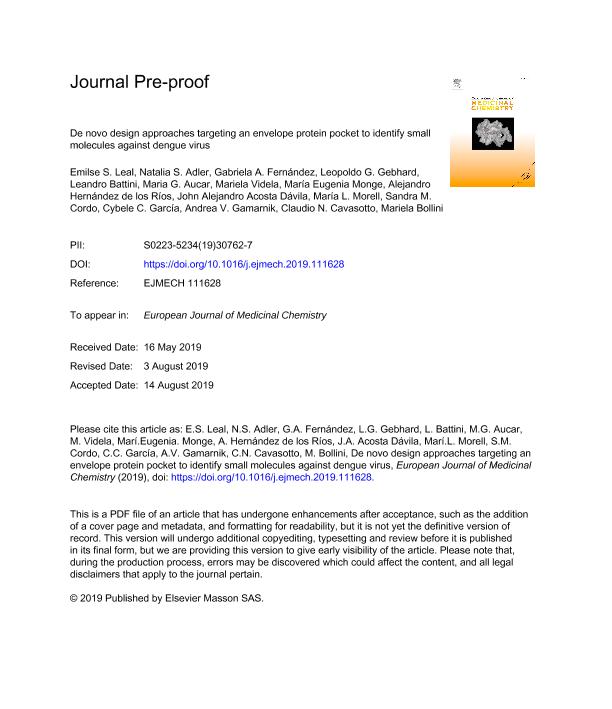Artículo
De novo design approaches targeting an envelope protein pocket to identify small molecules against dengue virus
Leal, Emilse Soledad ; Adler, Natalia Sol
; Adler, Natalia Sol ; Fernandez, Gabriela Araceli
; Fernandez, Gabriela Araceli ; Gebhard, Leopoldo German
; Gebhard, Leopoldo German ; Battini, Leandro
; Battini, Leandro ; Aucar, María Gabriela
; Aucar, María Gabriela ; Videla, Mariela
; Videla, Mariela ; Monge, Maria Eugenia
; Monge, Maria Eugenia ; Hernández de los Ríos, Alejandro; Acosta Dávila, John; Morell, María L.; Cordo, Sandra Myriam
; Hernández de los Ríos, Alejandro; Acosta Dávila, John; Morell, María L.; Cordo, Sandra Myriam ; García, Cybele C.; Gamarnik, Andrea Vanesa
; García, Cybele C.; Gamarnik, Andrea Vanesa ; Cavasotto, Claudio Norberto
; Cavasotto, Claudio Norberto ; Bollini, Mariela
; Bollini, Mariela
 ; Adler, Natalia Sol
; Adler, Natalia Sol ; Fernandez, Gabriela Araceli
; Fernandez, Gabriela Araceli ; Gebhard, Leopoldo German
; Gebhard, Leopoldo German ; Battini, Leandro
; Battini, Leandro ; Aucar, María Gabriela
; Aucar, María Gabriela ; Videla, Mariela
; Videla, Mariela ; Monge, Maria Eugenia
; Monge, Maria Eugenia ; Hernández de los Ríos, Alejandro; Acosta Dávila, John; Morell, María L.; Cordo, Sandra Myriam
; Hernández de los Ríos, Alejandro; Acosta Dávila, John; Morell, María L.; Cordo, Sandra Myriam ; García, Cybele C.; Gamarnik, Andrea Vanesa
; García, Cybele C.; Gamarnik, Andrea Vanesa ; Cavasotto, Claudio Norberto
; Cavasotto, Claudio Norberto ; Bollini, Mariela
; Bollini, Mariela
Fecha de publicación:
09/2019
Editorial:
Elsevier France-editions Scientifiques Medicales Elsevier
Revista:
European Journal of Medical Chemistry
ISSN:
0223-5234
Idioma:
Inglés
Tipo de recurso:
Artículo publicado
Clasificación temática:
Resumen
Dengue fever is a mosquito-borne viral disease that has become a major public health concern worldwide. This disease presents with a wide range of clinical manifestations, from a mild cold-like illness to the more serious hemorrhagic dengue fever and dengue shock syndrome. Currently, neither an approved drug nor an effective vaccine for the treatment are available to fight the disease. The envelope protein (E) is a major component of the virion surface. This protein plays a key role during the viral entry process, constituting an attractive target for the development of antiviral drugs. The crystal structure of the E protein reveals the existence of a hydrophobic pocket occupied by the detergent n-octyl-β-d-glucoside (β-OG). This pocket lies at the hinge region between domains I and II and is important for the low pH-triggered conformational rearrangement required for the fusion of the virion with the host's cell. Aiming at the design of novel molecules which bind to E and act as virus entry inhibitors, we undertook a de novo design approach by “growing” molecules inside the hydrophobic site (β-OG). From more than 240000 small-molecules generated, the 2,4 pyrimidine scaffold was selected as the best candidate, from which one synthesized compound displayed micromolar activity. Molecular dynamics-based optimization was performed on this hit, and thirty derivatives were designed in silico, synthesized and evaluated on their capacity to inhibit dengue virus entry into the host cell. Four compounds were found to be potent antiviral compounds in the low-micromolar range. The assessment of drug-like physicochemical and in vitro pharmacokinetic properties revealed that compounds 3e and 3h presented acceptable solubility values and were stable in mouse plasma, simulated gastric fluid, simulated intestinal fluid, and phosphate buffered saline solution.
Archivos asociados
Licencia
Identificadores
Colecciones
Articulos(CIBION)
Articulos de CENTRO DE INVESTIGACIONES EN BIONANOCIENCIAS "ELIZABETH JARES ERIJMAN"
Articulos de CENTRO DE INVESTIGACIONES EN BIONANOCIENCIAS "ELIZABETH JARES ERIJMAN"
Articulos(IIMT)
Articulos de INSTITUTO DE INVESTIGACIONES EN MEDICINA TRASLACIONAL
Articulos de INSTITUTO DE INVESTIGACIONES EN MEDICINA TRASLACIONAL
Articulos(IQUIBICEN)
Articulos de INSTITUTO DE QUIMICA BIOLOGICA DE LA FACULTAD DE CS. EXACTAS Y NATURALES
Articulos de INSTITUTO DE QUIMICA BIOLOGICA DE LA FACULTAD DE CS. EXACTAS Y NATURALES
Citación
Leal, Emilse Soledad; Adler, Natalia Sol; Fernandez, Gabriela Araceli; Gebhard, Leopoldo German; Battini, Leandro; et al.; De novo design approaches targeting an envelope protein pocket to identify small molecules against dengue virus; Elsevier France-editions Scientifiques Medicales Elsevier; European Journal of Medical Chemistry; 182; 9-2019; 1-49
Compartir
Altmétricas



